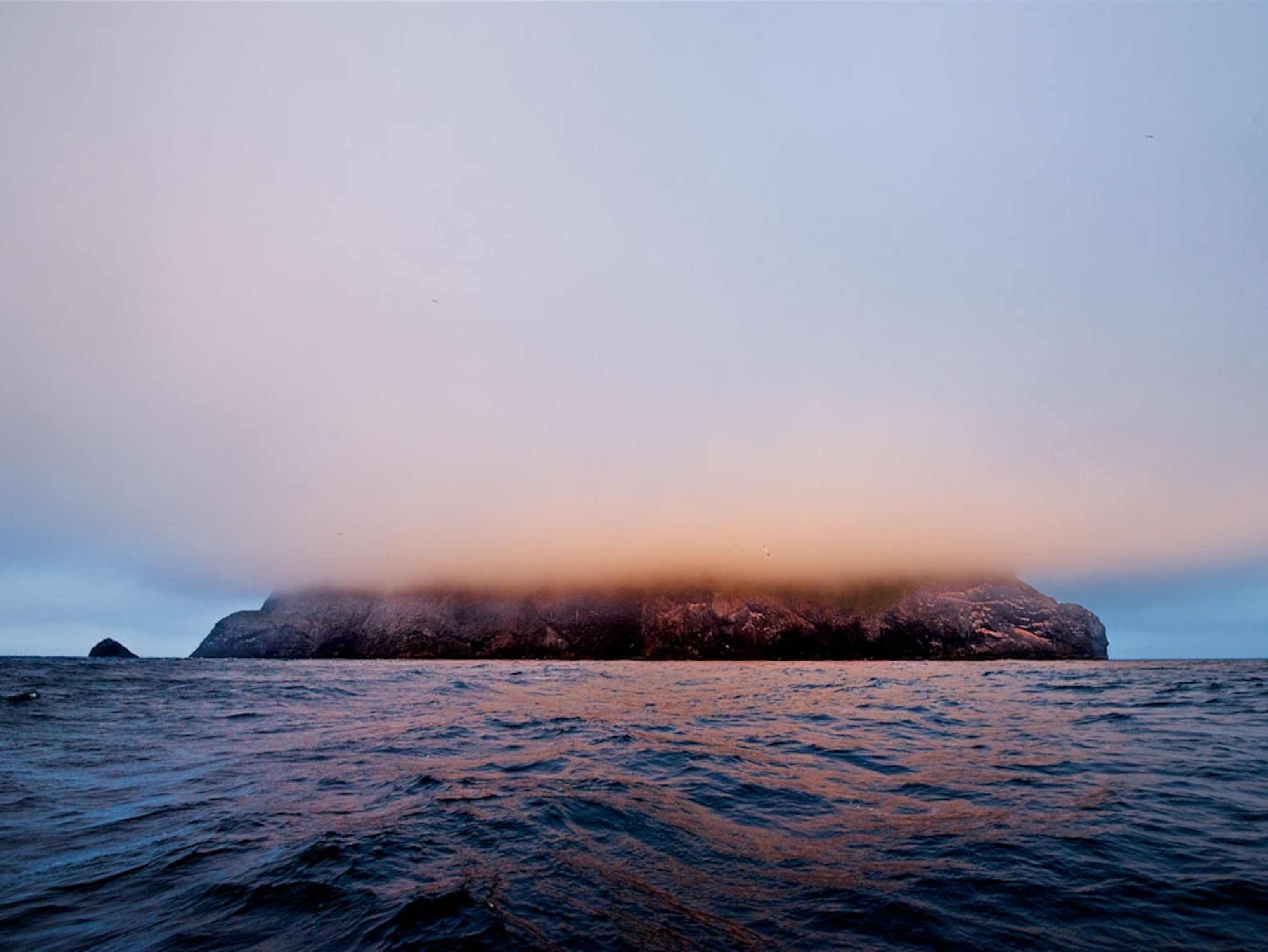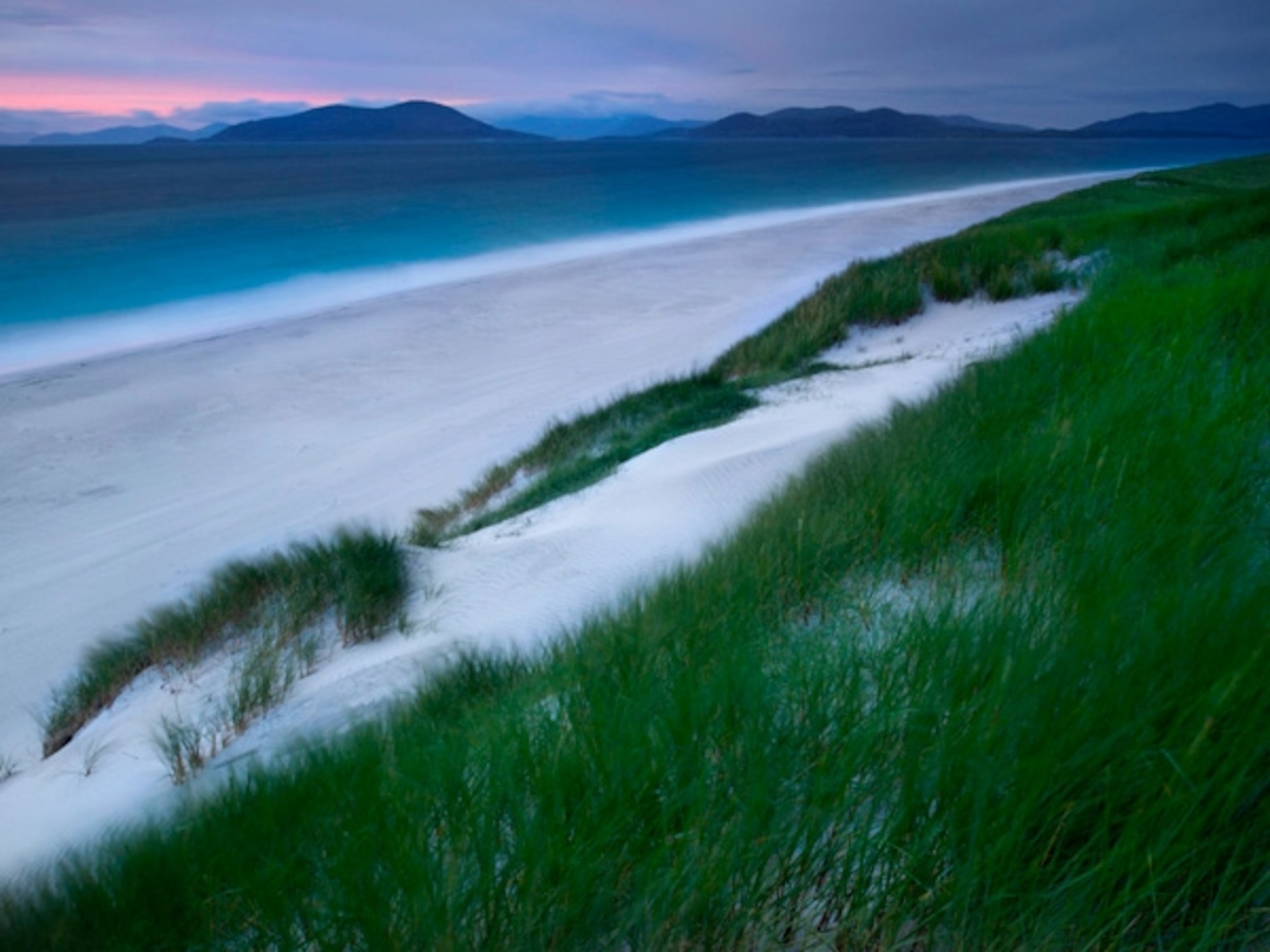Contributing editor Jim Richardson is a photojournalist recognized for his explorations of small-town life. His photos appear frequently in National Geographic magazine.
This is the story of frame number 10,525.
I took 14,976 pictures for my coverage of the Hebrides Islands of Scotland, and frame 10,525 is the one that made it to the opening spread of "Edge of the World" in the January 2010 issue of National Geographic magazine.
From the time I wrote my original Hebrides proposal, through the research and photography in the field, and finally to hammering out layouts at headquarters in Washington, D.C., I faced myriad paths and detours, each offering possibilities and failings. Out of this maze of blind luck and essential insight came one moment, one photograph, that somehow rose to claim the layout's prime position on the story's opening page.
Today and in the days to come, I'm going to tell stories about all the pictures in the Hebrides story, detailing the circumstances that brought each to the page. Some stories will be about photographic technique; more likely I'll be talking about walking the knife edge of the creative process, with success and ecstasy on one side and failure and doom on the other.
It is this uncertainty—and hope—that drives me every day I'm in the field.
There was a reason I was on a ridge overlooking the Old Man of Storr on the Isle of Skye. It was because of the story proposal to National Geographic that I had written two and a half years ago. I could almost recite it by heart.
Here are the opening paragraphs:
"For countless millennia the North Atlantic has raged and stormed against the oldest exposed rocks in the world. This epic battle has forged one of the world’s great archipelagos, a brave band of islands, battered and scarred on the outer front lines, towering and defiant in the inner keep, by turns alluring and heartless, yet always revered for their sheer tenacity.
"It is landscape in places, seascape in others. Fjords slice deep into the towering mountain islands while the low-lying islands remain barely afloat, waterlogged and pock-marked with thousands of lochs. Names betray the races of men who have tried to claim them: Barra and Eriksay, Coll and Tiree, the Uists, and our romantic favorite, The Isle of Skye. On his island sojourn composer Felix Mendelssohn was enchanted by what he saw and he wrote a haunting overture. What else could he call it?"
"The Hebrides."
So, with a few words, long before I had ever set foot in Scotland to begin shooting, I had fixed a very specific idea in the minds of National Geographic editors. I had to come back with an image that showed that idea. It had to look wild, a bit primordial, with great geologic forces at work, fresh and alive, like some battle being waged by the rocks. A pretty landscape wouldn't do—not for the story's opening spread. Grandeur would be all right, but the image also needed a raw-toothed, almost brutal, quality to it. It needed to speak to the Earth's monumental forces at work.
Well, the Hebrides are nothing if not the story of monumental forces. These lands wandered the Earth, were once south of the Equator before coming north and slamming into the European landmass. The rocks are ancient beyond human understanding, some of them three billion years old, among the oldest. These islands held fast against the raging Atlantic for millions of years.
For anyone looking for geology in action, the Isle of Skye is mecca. It provides an incredible mix of landforms and topography. On the day this picture was taken, I hiked up to the Old Man of Storr on the Trotternish Peninsula. (A local guide had clued me into the hidden path up to the cliffs above.) From there you can see the largest landslip in the British Isles. A huge chunk of Skye simply slid down and away into the sea toward the neighboring island of Raasay (on the left in this image). Left standing were the jagged teeth of the Old Man of Storr.
Truth be told, I almost didn't make the hike because of the dead, blank, gray overcast skies. And when I got up there it remained gray—for hours. At about 7 p.m. I started to see enough variation in the sky to give me hope that something might happen. To the west over the sea, I could see a few shafts of light—if only they would come my way. And one of them did. Trouble was, the sun was going down all the time, and the Old Man sits in the shadow of a big cliff. If the light didn't get there soon it would be too late. The light would never reach the Old Man.
Finally at 7:28:22 p.m. the first hint of light started to peek through, but it was weak. By 7:31:03 p.m., on frame 10,517, the light was better but I was so taken with the whole grand scene that I was shooting too wide. The blue sky with broken clouds was making the whole image too cheery. I had begun to figure this out by 7:31:26 p.m., on frame 10,520, when I came in tighter. In every subsequent frame, I cropped closer, making the sky all gray in looming clouds. As I did, the stones grew ever larger in the frame. At 7:32:00 p.m. I shot frame 10,525, which would become the hero of the day.
But at that moment, I didn't know I had the lead picture. I kept shooting. By 7:33:03 p.m., on frame 10,534, shadows were creeping ever higher. At 7:33:55 p.m. the last light vanished from the Old Man's tip. After two more hours and 300 more pictures, I hiked down the mountain in the dark. The next morning I hiked back up to the overlook at 4 a.m. and shot another 500 pictures of sunrise. It was a glorious scene.
That was August 23, 2008. Six months later, in February 2009, I was in Washington, D.C., working with National Geographic Illustrations Editor Sarah Leen and Design Editor John Baxter. Thank God for their fresh eyes, frank evaluation, and just plain hard work. Picking the lead picture is often the most difficult part of pulling a set of photographs together. If the picture says the right thing and sets the right tone, much of the heavy lifting is already done. The rest of the story flows organically from there. We had chosen frame 10,525 from other nearly identical images I shot that day. Why? Because of the precise alignment of the light with the line of the land behind it. The looming gray clouds gave it a brooding mood.
John experimented with other photographs for the opening spread, but it was clear early on that this photograph was the one. Not only did it set the visual tone, it also showed the geology and nature of the islands and surrounding seas. Far in the distance were the Red and Black Cuillins looking a bit like the ominous Mordor from The Lord of the Rings.
Frame 10,525 still had to pass muster during the final wall walk. There we showed the layouts—pinned to the wall—to the rest of the National Geographic editors (and mostly to Editor in Chief Chris Johns). It went without a hitch. So here it is—10,525, an old and trusted friend by now—in the January 2010 issue of National Geographic magazine.
Go Further
Animals
- This ‘saber-toothed’ salmon wasn’t quite what we thoughtThis ‘saber-toothed’ salmon wasn’t quite what we thought
- Why this rhino-zebra friendship makes perfect senseWhy this rhino-zebra friendship makes perfect sense
- When did bioluminescence evolve? It’s older than we thought.When did bioluminescence evolve? It’s older than we thought.
- Soy, skim … spider. Are any of these technically milk?Soy, skim … spider. Are any of these technically milk?
- This pristine piece of the Amazon shows nature’s resilienceThis pristine piece of the Amazon shows nature’s resilience
Environment
- This pristine piece of the Amazon shows nature’s resilienceThis pristine piece of the Amazon shows nature’s resilience
- Listen to 30 years of climate change transformed into haunting musicListen to 30 years of climate change transformed into haunting music
- This ancient society tried to stop El Niño—with child sacrificeThis ancient society tried to stop El Niño—with child sacrifice
- U.S. plans to clean its drinking water. What does that mean?U.S. plans to clean its drinking water. What does that mean?
History & Culture
- Meet the original members of the tortured poets departmentMeet the original members of the tortured poets department
- Séances at the White House? Why these first ladies turned to the occultSéances at the White House? Why these first ladies turned to the occult
- Gambling is everywhere now. When is that a problem?Gambling is everywhere now. When is that a problem?
- Beauty is pain—at least it was in 17th-century SpainBeauty is pain—at least it was in 17th-century Spain
- The real spies who inspired ‘The Ministry of Ungentlemanly Warfare’The real spies who inspired ‘The Ministry of Ungentlemanly Warfare’
Science
- Here's how astronomers found one of the rarest phenomenons in spaceHere's how astronomers found one of the rarest phenomenons in space
- Not an extrovert or introvert? There’s a word for that.Not an extrovert or introvert? There’s a word for that.
- NASA has a plan to clean up space junk—but is going green enough?NASA has a plan to clean up space junk—but is going green enough?
- Soy, skim … spider. Are any of these technically milk?Soy, skim … spider. Are any of these technically milk?
Travel
- What it's like to hike the Camino del Mayab in MexicoWhat it's like to hike the Camino del Mayab in Mexico
- Is this small English town Yorkshire's culinary capital?Is this small English town Yorkshire's culinary capital?
- This chef is taking Indian cuisine in a bold new directionThis chef is taking Indian cuisine in a bold new direction








